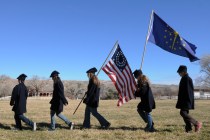Pahranagat Valley waters continue to attract visitors
A lush oasis where the Great Basin and Mojave Desert intersect, Pahranagat Valley in southern Lincoln County offers glimpses of a long and varied history.
Located about 90 miles from Las Vegas along U.S. Highway 93, Pahranagat Valley is home to several large working ranches near the little town of Alamo as well as the lakes, ponds and wetlands of the Pahranagat National Wildlife Refuge, one of several Southern Nevada refuges administered as the Desert NWR Complex.
Part of the expansive White River Drainage, the valley benefits from several large thermal springs that form several bodies of water, create meadows and wetlands and support stands of native cottonwoods, willows and other vegetation. Naturally attractive to wildlife and birds, both resident and migratory, the valley also attracted native cultures who hunted, farmed and lived in the valley thousands of years before European explorers reached the Americas.
The Paiute word paranagat means “place of many waters,” a fitting name for such an oasis.
The native people left minimal imprints upon the land they occupied, but signs of their presence are seen at several rock art sites in the vicinity. Some petroglyphs are located not far from the highway near Alamo, while more petroglyphs and a few pictographs are located on desert side roads to archaeological sites north of Alamo along the Sunnyside Cutoff. Scattered rock chips from tool making and broken pottery are often associated with the rock art, especially in historic campsites. All such artifacts are protected and should remain untouched.
Interested visitors can find directions at websites for Lincoln County or Nevada rock art on public lands. Search for a brochure called “The Greater Lincoln County,” put out by the county in association with the Nevada Commission on Tourism and the Bureau of Land Management. Information includes several interesting drives to rock art areas.
Pioneer ranchers reached the valley in the 1860s, creating pastures for livestock and planting orchards and truck gardens. Alamo was founded in 1901 to meet the needs of a growing population, but it never grew big enough to be incorporated. Get off U.S. 93 to explore Alamo’s few early buildings, including a small rock house, a 1917 schoolhouse turned residence, the 1930s high school repurposed as a school annex, a few modest homes with early 1900s flavor and a small desert cemetery where early residents were buried.
Established in 1964, the nearly 5,400-acre Pahranagat National Wildlife Refuge attracts at least 264 species of birds, as well as many desert animals, deer, coyotes and cougars. It draws increasing numbers of visitors who stop to enjoy picnicking, camping, wildlife viewing, photography, hiking, ranger programs and limited hunting and fishing.
Tall cottonwoods outline the margins of the lakes and marshes, providing shade for picnickers and campers. Fourteen no-frills campsites are available on a first-come basis. Bring water and firewood. These spots fill up quickly on weekends and holidays, especially during the fall, when the refuge is ablaze with seasonal color. Refuge brochures are available at the headquarters, reached via a side road. Two designated trails invite hikers and horsemen to explore.
Pahranagat Valley has two fairly new lodging options. Windmill Ridge Lodge features a bakery, restaurant and 15 comfortable Western-themed guest cabins. Cowboy’s Dream, a high-end Western-style bed-and-breakfast inn, offers luxurious suites, gourmet dining and personalized service for guests. Reservations are recommended at the lodge and the bed-and-breakfast. Check prices and details online at wind-mill-ridge.com or cowboysdream.com.
Margo Bartlett Pesek’s Trip of the Week column appears on Sundays.






















